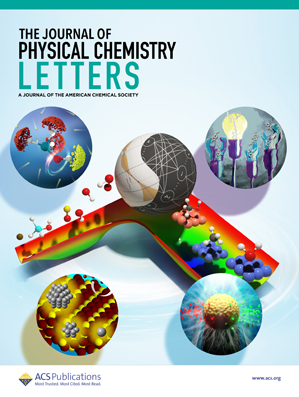Impact of Interfacial Structure on Heterogeneous Nucleation of Amorphous Carbonates
IF 4.8
2区 化学
Q2 CHEMISTRY, PHYSICAL
引用次数: 0
Abstract
Classical molecular dynamics simulations were performed to provide physical insight into the impact of interfacial structure on the heterogeneous nucleation of amorphous calcium carbonate (ACC, CaCO3·H2O) and amorphous magnesium carbonate (AMC, MgCO3·H2O) by using α-quartz as a model substrate. Interfacial structure and energies were computed for ACC and AMC in contact with the (100), (001), and (101) α-quartz surfaces. The simulations showed α-quartz surfaces drew water molecules out of the carbonate nuclei to form a partial hydration layer. The formation of a partial hydration layer and its disruption to the ACC/AMC structure meant the α-quartz–ACC/AMC interfaces were not energetically favored relative to separate α-quartz–water and ACC/AMC–water interfaces and, thus, homogeneous ACC/AMC nucleation was favored over heterogeneous nucleation. The CMD simulations hence provided an atomic-level explanation for a reported nonclassical growth mechanism whereby carbonate minerals grow via homogeneous nucleation and subsequent surface attachment of amorphous intermediates.

界面结构对非晶碳酸盐非均相成核的影响
以α-石英为模型基底,进行了经典分子动力学模拟,以深入了解界面结构对无定形碳酸钙(ACC,CaCO3-H2O)和无定形碳酸镁(AMC,MgCO3-H2O)异质成核的影响。计算了与 (100)、(001) 和 (101) α-quartz 表面接触的 ACC 和 AMC 的界面结构和能量。模拟结果表明,α-石英表面将水分子从碳酸核中吸出,形成部分水合层。部分水化层的形成及其对 ACC/AMC 结构的破坏意味着,相对于独立的 α-quartz 水界面和 ACC/AMC 水界面,α-quartz-ACC/AMC 界面在能量上并不占优势,因此,同质 ACC/AMC 成核比异质成核更受青睐。因此,CMD 模拟为一种非典型生长机制提供了原子层面的解释,即碳酸盐矿物通过均相成核和随后的无定形中间产物表面附着生长。
本文章由计算机程序翻译,如有差异,请以英文原文为准。
求助全文
约1分钟内获得全文
求助全文
来源期刊

The Journal of Physical Chemistry Letters
CHEMISTRY, PHYSICAL-NANOSCIENCE & NANOTECHNOLOGY
CiteScore
9.60
自引率
7.00%
发文量
1519
审稿时长
1.6 months
期刊介绍:
The Journal of Physical Chemistry (JPC) Letters is devoted to reporting new and original experimental and theoretical basic research of interest to physical chemists, biophysical chemists, chemical physicists, physicists, material scientists, and engineers. An important criterion for acceptance is that the paper reports a significant scientific advance and/or physical insight such that rapid publication is essential. Two issues of JPC Letters are published each month.
 求助内容:
求助内容: 应助结果提醒方式:
应助结果提醒方式:


